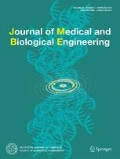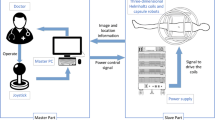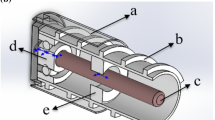Abstract
Wireless capsule endoscopes are a growing research area because they can be easily swallowed by patients to capture images of the digestive system without pain. However, a drawback of current capsule endoscopes is that most use passive motion. To overcome this drawback, a maneuverable capsule endoscope (MCE) based on a gimbaled ducted-fan (GDF) system is proposed in this study. The system design, prototype development of the GDF system, and associated modeling and simulation are presented. The concept of the GDF is adopted from the thrust-vector control algorithm of a space shuttle. To prevent organ damage, the ducted fan, which generates and controls the thrust required for achieving maneuverability, is mounted on a gimbal structure. A scaled-up prototype of the GDF system was manufactured. The overall conceptual design of the MCE based on the GDF system is presented. A flow simulation and a three-dimensional path-following simulation are performed to evaluate the proposed MCE’s applicability. The mean terminal velocity of the 6:1 scaled-up MCE prototype was calculated from flow simulation to be 0.6047, 0.5941, and 0.9204 m/s for the three postures of the GDF system, respectively, which represented the three translational degrees of freedom. For the 1:1 scale prototype, the mean terminal velocity was calculated to be 0.1147, 0.1127, and 0.1746 m/s for the above three postures, respectively. The proposed MCE dynamic model follows the desired path profile when the Lyapunov stability-based path-following algorithm was applied to it. In summary, the terminal velocity achieved in this research is sufficient for maneuvering inside the stomach organ. The results show that the MCE concept could be used for detecting and diagnosing abnormalities in the digestive system.









Similar content being viewed by others
References
CDC/NCHS National Hospital Discharge Survey: United States 2010. (2010). http://www.cdc.gov/nchs/data/nhds/10Detaileddiagnosesprocedures/2010det10_numberalldiagnoses.pdf.
Wilcox, C. M. (2009). Fifty years of gastroenterology at the University of Alabama at Birmingham: A festschrift for Dr. Basil I. Hirschowitz. American Journal of the Medical Sciences, 338, 84–88.
Shapiro, J. A., Klabunde, C. N., Thompson, T. D., Nadel, M. R., Seeff, L. C., & White, A. (2012). Patterns of colorectal cancer test use, including CT colonography, in the 2010 National Health Interview Survey. Cancer Epidemiology, 21, 895–904.
Seeff, L. C., Richards, T. B., Shapiro, J. A., Nadel, M. R., Manninen, D. L., Given, L. S., et al. (2004). How many endoscopies are performed for colorectal cancer screening? Results from CDC’s survey of endoscopic capacity. Gastroenterology, 127, 1670–1677.
Moore, L. E. (2003). The advantages and disadvantages of endoscopy. Clinical Techniques in Small Animal Practice, 18, 250–253.
Iddan, G., Meron, G., Glukhovsky, A., & Swain, P. (2000). Wireless capsule endoscopy. Nature, 405, 417.
Hara, K., Leighton, J. A., Sharma, V. K., Heigh, R. I., & Fleischer, D. E. (2005). Imaging of small bowel disease: Comparison of capsule endoscopy, standard endoscopy, barium examination and CT 1. RadioGraphics, 25, 697–711.
Lewis, B. S., & Swain, P. (2002). Capsule endoscopy in the evaluation of patients with suspected small intestinal bleeding: Results of a pilot study. Gastrointestinal Endoscopy, 56, 349–353.
Mylonaki, M., Fritscher-Ravens, A., & Swain, P. (2003). Wireless capsule endoscopy: A comparison with push enteroscopy in patients with gastroscopy and colonoscopy negative gastrointestinal bleeding. Gut, 52, 1122–1126.
Menciassi, A., Quirini, M., & Dario, P. (2007). Microrobotics for future gastrointestinal endoscopy. Minimally Invasive Therapy and Allied Technologies, 16, 91–100.
Moglia, A., Menciassi, A., Schurr, M. O., & Dario, P. (2007). Wireless capsule endoscopy: From diagnostic devices to multipurpose robotic systems. Biomedical Microdevices, 9, 235–243.
Delvaux, M., & Gay, G. (2008). Capsule endoscopy: Technique and indications. Best Practice & Research Clinical Gastroenterology, 22, 813–837.
Nakamura, T., & Terano, A. (2008). Capsule endoscopy: Past, present, and future. Journal of Gastroenterology, 43, 93–99.
Mosse, C. A., Mills, T. N., Appleyard, M. N., Kadirkamanathan, S. S., & Swain, C. P. (2001). Electrical stimulation for propelling endoscopes. Gastrointestinal Endoscopy, 54, 79–83.
Woo, S. H., Kim, T. W., Mohy-Ud-Din, Z., Park, I. Y., & Cho, J. H. (2011). Small intestinal model for electrically propelled capsule endoscopy. BioMedical Engineering Online, 10, 108.
Phee, L., Accoto, D., Menciassi, A., Stefanini, C., Carrozza, M. C., & Dario, P. (2002). Analysis and development of locomotion devices for the gastrointestinal tract. IEEE Transactions on Biomedical Engineering, 49, 613–616.
Wang, K., Yan, G., Ma, G., & Ye, D. (2009). An earthworm-like robotic endoscope system for human intestine: Design, analysis, and experiment. Annals of Biomedical Engineering, 37, 210–221.
Carpi, F., Galbiati, S., & Carpi, A. (2006). Magnetic shells for gastrointestinal endoscopic capsules as a means to control their motion. Biomedicine & Pharmacotherapy, 60, 370–374.
Carpi, F., & Pappone, C. (2009). Magnetic maneuvering of endoscopic capsules by means of a robotic navigation system. IEEE Transactions on Biomedical Engineering, 56, 1482–1490.
Liao, Z., Duan, X., Xin, L., Bo, L., Wang, X., Xiao, G., et al. (2012). Feasibility and safety of magnetic-controlled capsule endoscopy system in examination of human stomach: A pilot study in healthy volunteers. Journal of Interventional Gastroenterology, 2, 155–160.
Keller, J., Fibbe, C., Volke, F., Gerber, J., Mosse, A. C., Reimann-Zawadzki, M., et al. (2011). Inspection of the human stomach using remote-controlled capsule endoscopy: A feasibility study in healthy volunteers. Gastrointestinal Endoscopy, 73, 22–28.
Space Shuttle Main Engine. (2014). http://en.wikipedia.org/wiki/Space_Shuttle_main_engine.
Digestion (2014). http://en.wikipedia.org/wiki/Digestion.
Kim, S., Kim, Y., & Lee, C. (2014). Capsule endoscope. U.S. Patent 8,702,593, issued April 22, 2014.
Connor, A., Evans, P., Doto, J., Ellis, C., & Martin, D. E. (2009). An oral human drug absorption study to assess the impact of site of delivery on the bioavailability of bevirimat. Journal of Clinical Pharmacology, 49, 606–612.
Chi, B., Yao, J., Han, S. G., Xie, X., Li, G., & Wang, Z. (2007). Low-power transceiver analog front-end circuits for bidirectional high data rate wireless telemetry in medical endoscopy applications. IEEE Transactions on Biomedical Engineering, 54, 1291–1299.
Chen, X., Zhang, L., Li, X., Qi, N., Jiang, H., & Wang, Z. (2009). A wireless capsule endoscope system with low-power controlling and processing ASIC. IEEE Transactions on Biomedical Circuits and Systems, 3, 11–22.
Worsøe, J., Fynne, L., Gregersen, T., Schlageter, V., Christensen, L. A., Dahlerup, J. F., et al. (2011). Gastric transit and small intestinal transit time and motility assessed by a magnet tracking system. BMC Gastroenterology, 11, 145.
Lithium Battery. (2015). http://en.wikipedia.org/wiki/Lithium_battery.
Woods, S. P., & Constandinou, T. G. (2013). Wireless capsule endoscope for targeted drug delivery: Mechanics and design considerations. IEEE Transactions on Biomedical Engineering, 60, 945–953.
Encarnacao, P., & Pascoal, A. (2000). 3D path following for autonomous underwater vehicle. In Proceedings of the 39th IEEE conference on decision and control (Vol. 3, pp. 2977–2982).
Enderle, G., Kansy, K., & Pfaff, G. (1984) Coordinate systems and transformations. In Computer graphics programming (pp. 25–28). Berlin: Springer.
Drag Equation. (2014). http://en.wikipedia.org/wiki/Drag_equation.
White, F. M. (2008). Fluid mechanics (6th ed.). New York: McGraw-Hill.
Csendes, A., & Burgos, A. M. (2005). Size, volume and weight of the stomach in patients with morbid obesity compared to controls. Obesity Surgery, 15, 1133–1136.
Acknowledgments
This research was supported by Grant 0320140030 from the SNUH Research Fund and Global Ph. D. Fellowship Program through the National Research Foundation of Korea (NRF) funded by the Ministry of Education (Grant 2014H1A2A1020384).
Author information
Authors and Affiliations
Corresponding author
Rights and permissions
About this article
Cite this article
Kim, M., Lee, C., Lee, Y. et al. Maneuverable Capsule Endoscope Based on Gimbaled Ducted-Fan System: Concept and Simulation Results. J. Med. Biol. Eng. 36, 132–143 (2016). https://doi.org/10.1007/s40846-016-0105-4
Received:
Accepted:
Published:
Issue Date:
DOI: https://doi.org/10.1007/s40846-016-0105-4




